Creating a color mixing chart is a way for artists to study how colors interact with one another. They can be used by those who work paint with watercolor, acrylic, oil paints and any other medium you can mix colors with. It is an excellent way to learn more about color. While also creating a color mixing guide for you to refer to later.
Why color mixing charts are helpful
When creating color mixing charts, you get to mix every color with every other color. Doing this exercise allows you to mix some colors that you would otherwise never think of mixing together. So, it is a great way to discover some great new color mixtures and understand how colors work together!
Become more confident mixing colors
Creating a color chart can also help to boost your confidence when it comes to mixing colors for painting. Very often one might know what color one wants but has no idea how to mix it. However if you have already gone through the process of mixing all of your colors with each other. Then you will have a much better idea how to get the colors you need, with the colors you have.
How to make a color mixing chart
To start making a color chart you will need:
- A ruler
- a sheet of paper (or canvas if doing an oil paint color chart)
- All the colors you wish to use for your color chart
You can make color mixing charts with as few or as many colors as you would like. Keep in mind though, if you want to create a color chart mixing 24 colors… You will be mixing 576 squares! Yikes! The color chart directly below has just 7 colors, as it is a great starting point, with colors I use often.
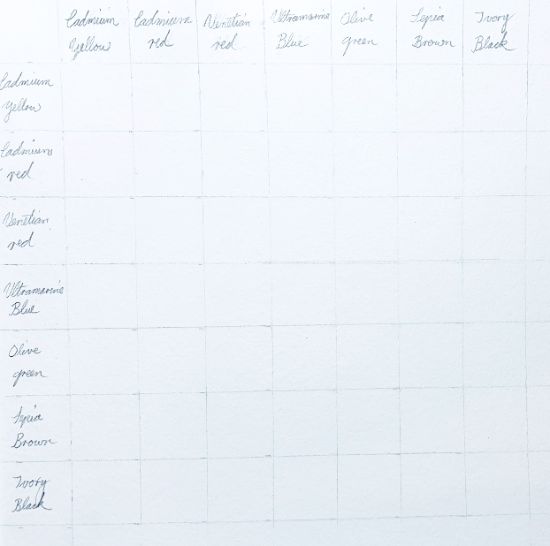
Paper I used for painting color mixing chart
To make the above chart I grabbed a sheet of 9 x 12 watercolor paper. As I made this color chart with watercolor paints. You can also use watercolor paper if you are painting color charts with acrylic or gouache paint. You could technically use watercolor paper for an oil paint color mixing chart as well. Though it would not be archival. If you want your oil color mixing chart to last, use a sheet of primed canvas or primed heavyweight paper.
Begin by drawing the squares that will be used for the color chart mixing guide
Grab your ruler and measure out your color chart so that you have one inch square of space for each area. I also left one inch of space from the margin for the side and upper margin where I labeled the color names. I made each of my squares one inch but you can make the squares as small or big as you like!
Write the name of each color on the margin of the color mixing chart
Label each of the squares on the left side and top margin. You will be labeling the same color on each side in the same order- as can be seen in the sample image below.

Add reference spots of color
Next, paint a spot of color next to each respective color name as seen in the image below. This serves as a reminder of what the color looks like next to the color name.

Begin filling in the boxes of the color chart
We begin by painting color chart boxes with their respective colors in in a diagonal line. So, the first square is filled with cadmium yellow, the square next to it is cadmium red and so on and so forth…
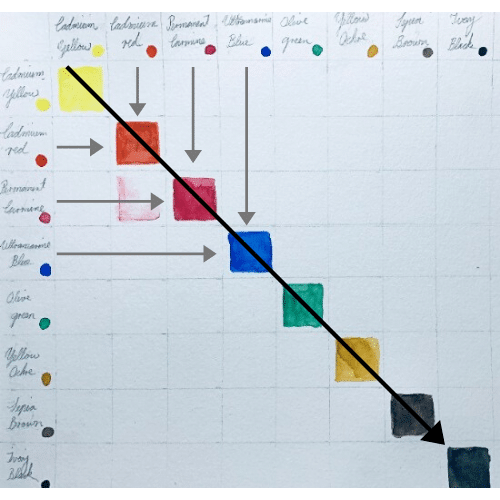
Start mixing color chart colors!
Now, comes the fun part of creating a color chart. You get to start actually mixing colors! When you are at the Cadmium red spot on the upper margin and move down to Ultramarine blue you will then mix cadmium red and ultramarine blue together.
You will do this for every single one of the colors. You will notice however that you create two sets of each color mixture. So, for each time that you mix cadmium + Ultramarine blue, you mix it a second time on the other side of the diagonal line.
If you haven’t already – grab my FREE Color Mixing Guide for helpful color mixing instructions and techniques!
Create the color mix with 50% of each color
If you are wondering how much of each color to put in a mixture, you will always do 50% of each. So, when you mix ultramarine blue + cadmium yellow you will mix 50% of cadmium yellow + 50% of ultramarine blue. This way it is an equal color mixture.
A dark area and light area on your color chart
Because it would not make much sense to mix the same color in the same manner twice. You will first create a color mixture that is light and then one that is darker the second time. See the image below and how the left side of the color chart is lighter and the right side is darker.
Putting down the base colors in 3 directions – each with a different tonal value
In addition, you will be putting down your base colors three times. Once horizontally along the first top row of squares. Once vertically along the first left row of squares and then once diagonally down and across the middle. For clarification, when i say base colors, I mean the colors you are using that you wrote the names of.
You will put down these colors in three different values. On the far left margin the base colors will be lightest in value. Along the middle, diagonal line they will be a medium value. Then along the upper margin the colors will be the darkest value. This portion of the color chart creation will really help you in understanding tonal values and how to create them.
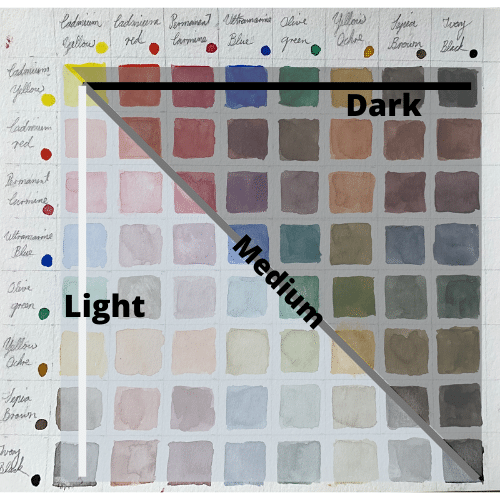
A note about different paint mediums
The color mixing chart used in this article is made with watercolor. However, the principles are the same no matter what medium you use. Whether it is acrylic, oil paint, gouache or something else!
When mixing your lighter colors with watercolor you will use less pigment and more water. However, when mixing a color chart with oil paint, acrylic or gouache you will use white to lighten your colors.
Last but never least… Mixing all of the colors for your color mixing chart!
Now all that is left, is to go ahead and mix all of the colors for your color chart! It can take a little bit of time to mix all of the colors… However, the learning is in the process of mixing colors and making the color chart! It can be a fun process of discovery, as you learn what color is made when each color is mixed together.

How to use your color chart
Now that you have a beautiful rainbow looking color mixing chart how do you use it?? Not only do you learn quite a bit while making a color chart. It can also serve as a useful reference and color mixing guide for when you work on your own projects. For example, if you are ever stumped and unsure how to get a particular color. Take a look at your color mixing chart as a reference, to see which colors you need to mix.
Also, you can add to your color chart mixing in new colors as you purchase them. It is a great way of getting to know your new color. As well as what kinds and shades of colors that can be mixed with it!
Recommended resources for making a color mixing chart
Here is the exact same watercolor paper I used to create the color mixing chart in this article.
Want to remember this? Save How to Make a Color Mixing Chart to your favorite Pinterest board!

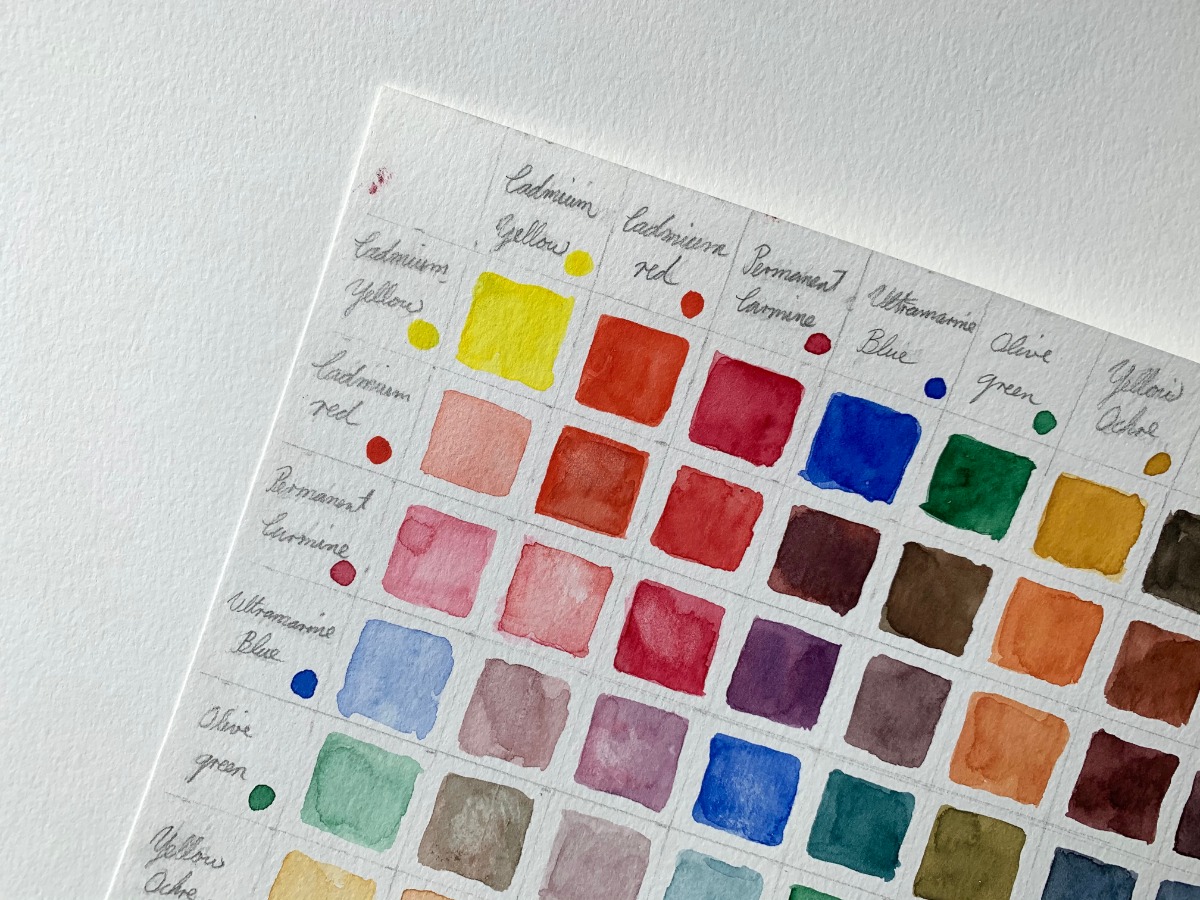






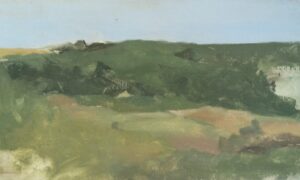
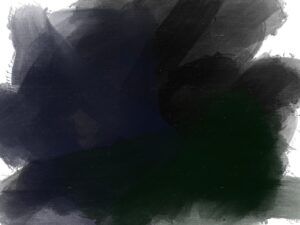
10 thoughts on “How to Make a Color Mixing Chart – Color Mixing Guide for Artists”
I am considering starting a beginner’s watercolor group at our senior center even though I only consider myself a novice watercolorist. As a retired teacher (mathematics) if I do this I will want to do the best job possible and this is a perfect example of something I would want to do with the group. I made a huge mixing chart for my 24-color set and it took far too long and was too big for quick reference so I really like your reduced list of pigments. When I made my chart I used 1/4″ painter’s tape to mask the rows and columns. But I wish I had known to go back and push down the tape an extra time to be sure it was adequately stuck to the paper to prevent bleeding underneath.
Hi Priscilla, That is wonderful that you plan to join a beginner’s watercolor group. You can learn a lot by joining in with others. Am glad that the reduced list of pigments is helpful – one often learns more about mixing when using less pigments. Thank you for noting that you wished to know sooner about pressing down on the painters tape so that no color would bleed through – this will be a good tip to add to this tutorial. Good luck with the watercolor group!
hi Elisabeth… sue g here in PA.. I am a beginner and have a question… so diagonal middle is 100 of base… then right side is 50/50 and left side is adding 1 part white to the mixed color on right? so would it then be logical to paint diagonal 1st…50/50 dark mix 2nd… and 3rd mix being adding white to that color? so after the diagonal I would do my 50/50 then that 50/50 color mixed with white? how much white? 50/50?
Really learning so much from you… so appreciate all your sharing and kindness!
sue g🎨🎨🎨
Hi Sue! Very happy to hear that you are learning a lot – and must add that I love PA! Apologies for my delayed reply – I hope I fully understand your question and will try to answer the best I can. Yes the colors on the diagonal are the pure color as it is. The left side lightens the color – if painting with acrylics or oils you would add some white – if painting with watercolors you would just add some water to lighten the color. Consistency is more important than amounts in the color chart so I recommend keeping the amount of white you mix into the left lightened side consistent – so if you do 50/50 do so for all colors. I personally did more of a 50/50 mixture 🙂 You definitely could first put the diagonal color down first, then mix up the dark side and then lighten that color for the left side.
I hope that helps! Best wishes to you
Hi -can you please resend the free color quide- for some reason it’s not making it to me.
Also I believe I saw that your e -course can be provided In a pdf format?
Thanks
Hi Susan, I just sent you an e-mail with the color mixing guide 🙂
Thank you. That is the best explanation of a color chart that I have read. The first time I saw a color chart I was blown away by the many colors that were created. I have wanted to create one ever since but was unsure about how to go about doing it.
So glad to hear that! Thank you for sharing 🙂
This will be very helpful as my teacher assigned two color chart projects! Thank you.
Sharman
Glad to hear that! You are very welcome 😉